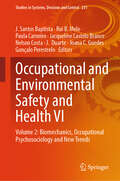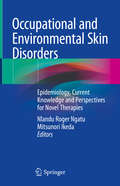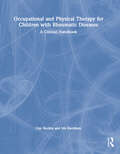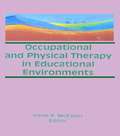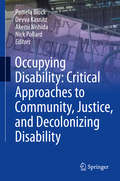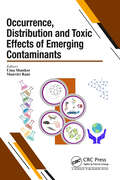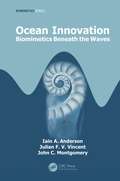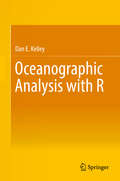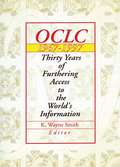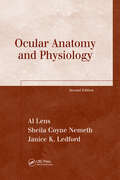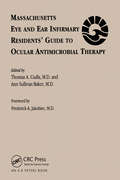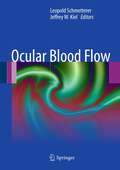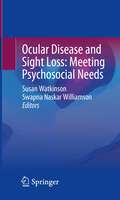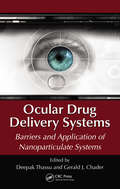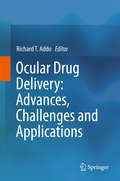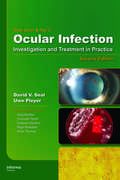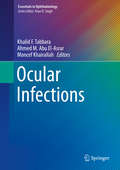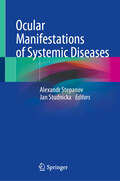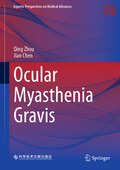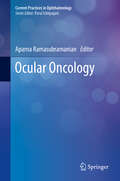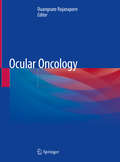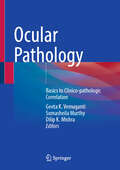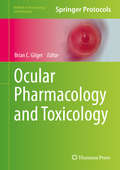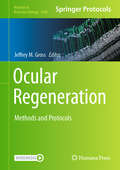- Table View
- List View
Occupational and Environmental Safety and Health VI: Volume 2: Biomechanics, Occupational Psychosociology and New Trends (Studies in Systems, Decision and Control #231)
by Paula Carneiro Nelson Costa Rui B. Melo Gonçalo Perestrelo J. Santos Baptista Joana Duarte Jacqueline Castelo Branco Joana C. GuedesThis book gathers cutting-edge research and best practices relating to occupational risk and safety management, healthcare, and ergonomics. It covers strategies for different industries, such as construction, chemical, and healthcare. It emphasizes challenges posed by automation, discusses solutions offered by technologies, and reports on case studies carried out in different countries. Chapters are based on selected contributions to the 21st International Symposium on Occupational Safety and Hygiene (SHO 2024), held on July 4-5, 2024, in Porto, Portugal. By reporting on different perspectives, such as the ones from managers, employees, and OSH professionals, and covering timely issues, such as implications of telework, issues related to gender inequality and applications of machine learning techniques in occupational health, this book offers extensive information and a source of inspiration to OSH researchers, practitioners, and organizations operating in both local and global contexts. This is the second volume of a 2-volume set.
Occupational and Environmental Skin Disorders: Epidemiology, Current Knowledge and Perspectives for Novel Therapies
by Nlandu Roger Ngatu Mitsunori IkedaThis book provides cutting-edge information on the epidemiology, etiology and pathophysiology of several prevalent occupational and environmental skin diseases (OSD/ESD), with a particular focus on skin health safety issues, risk factors, preventive measures and recent advances in the management of these diseases. It also highlights recent discoveries and developments concerning novel therapeutic agents for inflammatory OSD, especially findings that are supported by clinical data and have the potential to transform conventional prophylactic and therapeutic approaches. For example, despite their increasing prevalence, the management of allergic skin diseases is sometimes challenging, mainly due to limited treatment choices. In several countries, steroids are the only treatment used. However, in cases of contraindications, adverse effects or unsatisfactory steroidal therapies, alternative treatments are indispensable. As such, an understanding of promising anti-allergic agents enhances allergy research and could eventually lead to novel alternative therapeutic and adjuvant remedies, which are of the utmost importance. This book offers a valuable resource for researchers, graduate students and practitioners in the field of public health in general, especially those working in environmental and occupational medicine, as well as physicians.
Occupational and Physical Therapy for Children with Rheumatic Diseases: A Clinical Handbook
by Gay Kuchta Iris Davidson Surrey Patel'This volume comes at an important time in the development of the discipline, and reflects the knowledge gained by the authors through decades of hands-on experience of treating children and adolescents with the entire spectrum of rheumatic diseases. It emphasizes the integration of the expertise of all health care providers in an interactive team' - Ross Petty in the Foreword. This highly practical handbook is easy to read and refer to on a daily basis. The wide-ranging style encourages a multidisciplinary, team-based approach to provide continuity of care, and the handy binding and layout is designed to aid quick access of core information. Featuring over 230 full-colour images and reproducible resources for patients and carers, this guide is a vital resource for Allied Health Professionals, especially those working with children.
Occupational and Physical Therapy in Educational Environments
by Irene McewenOccupational and Physical Therapy in Educational Environments covers the major issues involved in providing lawful, team-oriented, and effective occupational and physical therapy services for students with disabilities in public schools. For those involved with students with disabilities, this book helps them make sound decisions about services that will make a meaningful difference in the lives of these children.Since the 1975 enactment of Public Law 94--142, which mandated that occupational and physical therapy be provided “as may be required by a handicapped child to benefit from special education,” this required link between therapy and education has continued to lead to confusion and controversy about which students should receive therapy in school and what types of services should be provided. The purpose of Occupational and Physical Therapy in Educational Environments is to clarify the major issues surrounding occupational and physical therapy in public schools, and to provide a framework for delivery of team- and family-oriented services that meet individual needs of students with disabilities.For those unsure of current regulations regarding handicapped students, or those who need clarification on the law, the book begins with a review of legislation and regulations. This begins to guide and shape schools’provision of therapy services. The following chapters assist occupational and physical therapists and important members of the educational teams of disabled students to make sound decisions about which students need school-based therapy services: Laws that Shape Therapy Services in Educational Environments: summarizes the major statutory law, federal regulations, and case law interpretation in which school-based practice is grounded. Pediatric Therapy in the 1990s: reviews contemporary theories of motor development, motor control, and motor learning that have had major impact on therapy for school-age children with disabilities. Related Services Decision-Making: describes a strong team approach to determining a student’s need for occupational and physical therapy services, which takes into account the unique characteristics of both the student and the educational team. Assessment and Intervention in School-Based Practice: describes an approach to assessment and intervention in schools that clearly illustrates a relationship between therapy and educational programs that result in meaningful outcomes for students. Challenges of Interagency Collaboration: reports on a qualitative study that points out that schools are not the only settings in which many students with disabilities receive services, so coordination between various agencies is essential to avoid gaps, overlaps, and cross purposes.Those who can benefit from Occupational and Physical Therapy in Educational Environments include occupational and physical therapists who work in public schools, school administrators, teachers, and even parents of disabled children.
Occupying Disability: Critical Approaches to Community, Justice, and Decolonizing Disability
by Nick Pollard Pamela Block Devva Kasnitz Akemi NishidaThis book explores the concept of "occupation" in disability well beyond traditional clinical formulations of disability: it considers disability not in terms of pathology or impairment, but as a range of unique social identities and experiences that are shaped by visible or invisible diagnoses/impairments, socio-cultural perceptions and environmental barriers and offers innovative ideas on how to apply theoretical training to real world contexts. Inspired by disability justice and "Disability Occupy Wall Street / Decolonize Disability" movements in the US and related movements abroad, this book builds on politically engaged critical approaches to disability that intersect occupational therapy, disability studies and anthropology. "Occupying Disability" will provide a discursive space where the concepts of disability, culture and occupation meet critical theory, activism and the creative arts. The concept of "occupation" is intentionally a moving target in this book. Some chapters discuss occupying spaces as a form of protest or alternatively, protesting against territorial occupations. Others present occupations as framed or problematized within the fields of occupational therapy and occupational science and anthropology as engagement in meaningful activities. The contributing authors come from a variety of professional, academic and activist backgrounds to include perspectives from theory, practice and experiences of disability. Emergent themes include: all the permutations of the concept of "occupy," disability justice/decolonization, marginalization and minoritization, technology, struggle, creativity and change. This book will engage clinicians, social scientists, activists and artists in dialogues about disability as a theoretical construct and lived experience.
Occurrence, Distribution and Toxic Effects of Emerging Contaminantsx
by Uma Shanker Manviri RaniEmerging contaminants include an extensive array of synthetic chemicals in global use, such as plastic additives, microplastics, water disinfection byproducts, pharmaceuticals, man-made nanomaterials, and UV-filters. Because of their extensive use in anthropogenic activities, these chemicals are entering the environment at alarming levels as hazardous wastes and non-biodegradable substances. This book emphasizes on the comprehensive information on emerging contaminants overview, environmental occurrence, analysis, risk assessment and toxicity assessment. Environmental, legal, health concerns of the ECs have also been covered in this book. The book also features an updated status from the industrial point of view.
Ocean Innovation: Biomimetics Beneath the Waves (Biomimetics Series)
by John Montgomery Julian Vincent Iain A. AndersonBiomimetics is the idea of creating new technologies abstracted from what we find in biology. Ocean Innovation: Biomimetics Beneath the Waves seeks that technological inspiration from the rich biodiversity of marine organisms. Bringing both a biological and engineering perspective to the biomimetic potential of oceanic organisms, this richly illust
Oceanographic Analysis with R
by Dan E. KelleyThis book presents the R software environment as a key tool for oceanographic computations and provides a rationale for using R over the more widely-used tools of the field such as MATLAB. Kelley provides a general introduction to R before introducing the ‘oce’ package. This package greatly simplifies oceanographic analysis by handling the details of discipline-specific file formats, calculations, and plots. Designed for real-world application and developed with open-source protocols, oce supports a broad range of practical work. Generic functions take care of general operations such as subsetting and plotting data, while specialized functions address more specific tasks such as tidal decomposition, hydrographic analysis, and ADCP coordinate transformation. In addition, the package makes it easy to document work, because its functions automatically update processing logs stored within its data objects. Kelley teaches key R functions using classic examples from the history of oceanography, specifically the work of Alfred Redfield, Gordon Riley, J. Tuzo Wilson, and Walter Munk. Acknowledging the pervasive popularity of MATLAB, the book provides advice to users who would like to switch to R. Including a suite of real-life applications and over 100 exercises and solutions, the treatment is ideal for oceanographers, technicians, and students who want to add R to their list of tools for oceanographic analysis.
Oclc 1967: Thirty Years of Furthering Access to the World's Information
by K. Wayne SmithIn OCLC 1967--1997: Thirty Years of Furthering Access to the World's Information, you'll see how libraries, librarians, and librarianship have changed dramatically since the late sixties, when OCLC was founded as a nonprofit, membership, computer library service and research organization. You'll also see how far information professionals have come in their common crusade to provide access to the ever-expanding body of information worldwide. OCLC 1967--1997 gives you both a look back and a look forward across thirty years of continuous technological change as OCLC grows from an Ohio network of 54 academic libraries to a global network of 26,000 libraries in 65 countries. Eighteen experienced authors give you a panoramic overview and specific insight into OCLC as both a membership organization and a provider of computer services. You'll see how libraries and librarians have an institutionalized voice for libraries in OCLC&’s strategic directions. And, you'll better understand how the shared commitment of OCLC members to the ideals of research, scholarship, and education has created a unique library resource--WorldCat--which has become the most consulted database in higher education. Specifically, you'll read about: the changing tasks of cataloging, from automatic processing of print materials to the new challenges of electronic metadata the revolution in reference services and resource sharing OCLC in Asia Pacific, Europe, and Latin America today's leading-edge electronic libraries--GALILEO and the CIC VEL research at OCLC the new electronic scholarshipOCLC 1967--1997 is for library professionals in libraries of all types. It is a definitive guidebook to today's OCLC and to all those who are helping their libraries and staffs deal with the challenges and opportunities of the Information Age.
Ocular Anatomy and Physiology (The Basic Bookshelf for Eyecare Professionals)
by Janice K. Ledford Al Lens Sheila Coyne NemethUpdated to include new material for beginners in ophthalmology and optometry, Ocular Anatomy and Physiology, Second Edition is an essential text that covers a range of fundamental information for students and clinicians. With collaborations from Al Lens, Sheila Coyne Nemeth, and Janice K. Ledford, Ocular Anatomy and Physiology, Second Edition now begins with a jump-start chapter to overview the topic for those new to the field of eye care. Chapter two delves into embryology—a topic rarely covered—and addresses each structure of the eye, including the bony orbit, eyebrows, eye lids, lacrimal system, extraocular muscles, and the globe. While the text continues to emphasize normal anatomy, each chapter contains a glossary of common disorders. Also included is a description of diagnostic methods for examining various tissues. The physiology of various structures and systems is explained, including the visual pathway, the inflammatory response, immunology, binocular vision, refractive errors, and accommodation. To enhance the reader’s understanding of each topic, illustrations are provided.Features of the Second Edition: New jump-start chapter for beginners Details on diagnostic methods for each structure or segment, including optical coherence tomography and retinal thickness analysis Glossary of common disorders at the end of each chapter With new features and information, Ocular Anatomy and Physiology, Second Edition is a valuable text for ophthalmic and optometric assistants, training facilities, and practices, as well as beginners in the field of eye care, including sales representatives and pre-med students.
Ocular Antimicrobial Therapy
by Thomas A. Ciulla Ann Sullivan BakerThis pocket handbook is a concise yet virtually encyclopedic review of commonly used antimicrobial therapy. It serves as a tool to facilitate initial treatment of common ocular and periocular infections. An essential vademecum for opthalmic trainees and clinicians.
Ocular Blood Flow
by Leopold Schmetterer Jeffrey KielAdequate blood supply to the eye is an important prerequisite for normal visual function. Over the past 40 years our knowledge of ocular blood flow regulation has improved significantly. This reader-friendly textbook provides a comprehensive overview of the current knowledge of ocular blood flow. Lavishly illustrated, it evaluates the wide array of methods that have been used to measure ocular blood flow. Furthermore, it not only offers the reader an evidence-based summary of the physiological and pharmacological properties of ocular blood flow regulation, but also demonstrates the ocular blood flow abnormalities in different vascular diseases. This book will enhance the understanding of all who are interested in learning more about ocular blood flow in health and disease.
Ocular Disease and Sight Loss: Meeting Psychosocial Needs
by Susan Watkinson Swapna Naskar WilliamsonBackground: Psychosocial care remains an extremely important part of the holistic approach to care, but one which has been underestimated in clinical practice and only superficially addressed in the ophthalmic literature to date. This aspect of care most often gets less attention by healthcare professionals due to the dominance of a technology-enhanced approach to caring practice. Clearly, the skills afforded by science and technology are important for healthcare professionals in practice, but it is also important for them to be aware of the impact of the transfer of such skills on patients from a humanistic perspective. The delivery of technology-enhanced care can often trigger innermost feelings and needs such as fear, anxiety, stress, loss of control, and a sense of alienation. This book seeks to address the imbalance often observed between nursing both as an art and science, and to emphasise the importance of raising the healthcare knowledge and understanding of the value of social psychology and its application to ophthalmic practice in addressing this imbalance. Main aims: (1) To discuss the psychosocial needs and care of patients with ocular disease and sight loss. (2) To discuss the importance and relevance of the psychosocial aspects of ophthalmic care with reference to psychosocial theory and its application. (3) To discuss the psychosocial role of the healthcare professional in facilitating emotional recovery and promoting quality of life in the care and management of patients with ocular disease and sight loss.
Ocular Drug Delivery Systems: Barriers and Application of Nanoparticulate Systems
by Deepak Thassu Gerald J. ChaderDrug discovery for ocular diseases has taken great strides in the last two decades. From cornea to choroid, new drugs have been formulated to address a great variety of ocular diseases. Yet without good drug delivery systems, these drugs are less effective than they might be or could even cause serious side effects. Ocular Drug Delivery Systems: Ba
Ocular Drug Delivery: Advances, Challenges and Applications
by Richard T. AddoThe eye is a computerized system that has been designed for self-defense, and these defense mechanisms create challenges in administration of medications to the eye. Therefore, ocular drug delivery has been a major challenge to drug delivery researchers. There are on-going studies, in search of treatment especially for the diseases affecting the posterior segment of the eye. This book gives and overview of the background of ocular drug delivery and is unique for pharmacists, medical practitioners, students and drug delivery researchers.
Ocular Infection: Investigation and Treatment in Practice
by Uwe Pleyer David V. SealSince the first edition that was published in 1998 we have seen manychanges in ophthalmology from advancements in laser surgery to new techniques in cataract surgery. With these new developing advancements symptoms, diagnosis, and treatments in ocular disease have also begun to change. Early diagnosis and management of ocular infection is essential
Ocular Infections
by Khalid F. Tabbara Ahmed M. Abu El-Asrar Moncef KhairallahOcular infections remain an important cause of ocular morbidity and loss of vision, yet many are preventable or curable. Early diagnosis and prompt treatment help in the control of such infectious disorders and the prevention of blindness. There are many infectious diseases of the eye and adnexa and knowledge of their diagnosis and management is essential to an optimal therapeutic outcome. This book provides the practitioner with the important information required to ensure appropriate diagnosis and management of ocular infectious diseases. Specific clinical signs and symptoms are outlined, and the role of specific diagnostic tests, including molecular biology techniques, is explained. All of the most common microorganisms are considered and current knowledge on the antimicrobial therapy of ocular infections is clearly summarized. Ocular Infections will be a great help to physicians as a guide to the care of patients with ocular infectious diseases.
Ocular Manifestations of Systemic Diseases
by Alexandr Stepanov Jan StudnickaThis book focuses on ocular manifestations of general human diseases with chapters divided according to the human organ system. Specialists in each field detail individual illnesses and ophthalmologists present an overview of ocular complications of these diseases. Manifestations of vascular, endocrine, autoimmune, rheumatological, pulmonary, gastrointestinal, hematological, infectious, skin, neurological, sexually transmitted and cancer diseases are discussed in detail throughout the book. Ocular Manifestations of Systemic Diseases is a highly illustrated guide with the basic data presented in clear tables and graphs with a further reading lists included for each topic. Ophthalmologists and experts in other fields, including general practitioners, will find this book to be an essential resource for their clinical and academic activities.
Ocular Myasthenia Gravis (Experts' Perspectives on Medical Advances)
by Qing Zhou Jian ChenThis book mainly introduces the progress of ocular myasthenia gravis from the aspects of epidemiology, etiology and inducement, pathogenesis, clinical features, auxiliary examination, diagnosis and differential diagnosis and treatment, etc. In addition to cover some progress in the treatment of ocular myasthenia gravis, the authors also discuss some issues with controversial. The diagnosis of ocular myasthenia gravis mainly depends on the clinical manifestations of the patient, and patients often do not seek medical treatment until they have obvious ptosis or double vision, which is easy to be missed and misdiagnosed. Treatment for ocular myasthenia gravis is mainly to relieve ocular symptoms and delay or prevent progression from ocular myasthenia gravis (OMG) to generalized myasthenia gravis (GMG). The authors highlight the early and correct diagnosis and treatment of OMG, which is the key to improve patients' quality of life and reduce OMG conversion rate. The translation was done with the help of artificial intelligence. A subsequent human revision was done primarily in terms of content, so that the book will read stylistically different from a conventional translation.
Ocular Oncology
by Daniel M. Albert Arthur PolansSurvival rates in cases of uveal melanoma and retinoblastoma - the leading intraocular malignancies in adults and children - may be high, but means of earlier diagnosis and improved treatment options are needed to preserve vision and prevent metastasis. This reference deals principally with the molecular biology and genetic factors which trigger an
Ocular Oncology (Current Practices in Ophthalmology)
by Aparna RamasubramanianThis book concentrates on ocular oncology covering the latest advances in both adult and pediatric oncology. The topics covered are: retinoblastoma, melanoma, graft vs. host disease, squamous cell neoplasia, intraocular lymphoma, coats disease, and choroidal hemangioma. Each chapter is written by an expert in the field and covers the most recent developments in management. As part of the series “Current Practices in ophthalmology” this volume is meant for residents, fellows-in-training, generalist ophthalmologists and specialists alike.
Ocular Oncology (Retina Atlas)
by Duangnate RojanapornThis atlas covers all aspects of retina, retinal pigment epithelium, and choroidal tumors, as well as other simulating lesions of intraocular tumors and paraneoplastic syndromes. Each chapter features numerous high-quality pictures based on multimodal imaging, including color fundus photography, fundus autofluorescence, optical coherence tomography, ultrasonography, ultra-widefield imaging, and fundus angiography. Designed to assist in the diagnosis and treatment of posterior segment intraocular tumors and simulating lesions, this book is intended for ocular oncologists, retina specialists, general ophthalmologists, residents and retina fellows. Ocular Oncology atlas is part of the series Retina Atlas, which provides global perspectives on vitreoretinal diseases, covering imaging basics, retinal vascular disease, macular disorders, ocular inflammatory and infectious disorders, retinal degeneration, surgical retina, ocular oncology, pediatric retina and trauma. Retina Atlas consists of 9 volumes and about 100 chapters, presenting validated and comprehensive information on retinal disorders.
Ocular Pathology: Basics to Clinico-pathologic Correlation
by Dilip K. Mishra Geeta K. Vemuganti Somasheila MurthyThis book covers the basic pathology of eye diseases with emphasis on clinicopathological correlation. It assists eye care professionals in integrating pathology and clinical practice as understanding of pathology is an integral part of clinical medicine. The book covers various diseases of the eye including infection, inflammation, tumors of all parts of the eye with appropriate illustrations of pathology microphotograph. It also includes the processing and handling of eye tissues. It covers routine, special stains and immune-histochemistry as applicable. It helps in clear understanding with a problem-based approach and case-based approach. The book will be extremely useful to ophthalmologists, pathologists, students of optometry, ophthalmic nursing and other eye professionals.
Ocular Pharmacology and Toxicology
by Brian C. GilgerCovering ocular pharmacokinetics, pharmacodynamics, and toxicology, "Ocular Pharmacology and Toxicology" provides ophthalmologists, toxicologists, and pharmacologists with both an introduction to the proper methods for ocular pharmacology and toxicology as well as providing practical methodologies for conducting ocular studies. Expert authors have contributed detailed chapters on study design, analysis, and routes to regulatory approval for various types and routes of ophthalmic drugs. As a volume in the "Methods in Pharmacology and Toxicology" series, chapters feature the kind of in-depth specifics and implementation advice to ensure successful results. Practical and authoritative, "Ocular Pharmacology and Toxicology" serves as an ideal basis of training in the proper design and conduct of essential studies to accurately determine pharmacokinetics and ocular toxicity from the systemic, topical, periocular, or intraocular administration of drugs or compounds, from the use of ocular medical devices and from ocular surgical procedures. "
Ocular Regeneration: Methods and Protocols (Methods in Molecular Biology #2848)
by Jeffrey M. GrossThis detailed volume presents state-of-the-art techniques in ocular regeneration research, pulling together recent animal model systems identifying key genes and regulatory networks that contribute to the regenerative response as well as advances in induced pluripotent stem cell (iPSC) biology. The book opens with a section on the anterior segment and key models and techniques utilized to study the cornea, lens, and trabecular meshwork, and continues with chapters on the posterior segment, and largely the retina and retinal pigment epithelium (RPE), with techniques developed in a variety of model systems to study regeneration of these tissues. The concluding part examines novel technologies utilized in ocular regeneration research. Written for the highly successful Methods in Molecular Biology series, chapters include introductions to their respective topics, lists of the necessary materials and reagents, step-by-step and readily reproducible laboratory protocols, and tips on troubleshooting and avoiding known pitfalls. Authoritative and practical, Ocular Regeneration: Methods and Protocols serves as an ideal guide for researchers aiming to expand the boundaries of what we know about this vital area of physiology.
